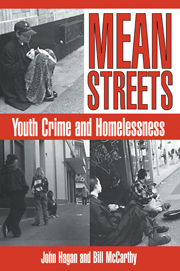Book contents
- Frontmatter
- Contents
- Foreword by James F. Short Jr.
- Acknowledgments
- List of Tables and Illustrations
- 1 Street and School Criminologies
- 2 Street Youth and Street Settings
- 3 Taking to the Streets
- 4 Adversity and Crime on the Street
- 5 The Streets of Two Cities
- 6 Criminal Embeddedness and Criminal Capital
- 7 Street Youth in Street Groups
- 8 Street Crime Amplification
- 9 Leaving the Street
- 10 Street Criminology Redux
- Appendix: The Methodology of Studying Street Youth
- Notes
- References
- Index
Appendix: The Methodology of Studying Street Youth
Published online by Cambridge University Press: 06 January 2010
- Frontmatter
- Contents
- Foreword by James F. Short Jr.
- Acknowledgments
- List of Tables and Illustrations
- 1 Street and School Criminologies
- 2 Street Youth and Street Settings
- 3 Taking to the Streets
- 4 Adversity and Crime on the Street
- 5 The Streets of Two Cities
- 6 Criminal Embeddedness and Criminal Capital
- 7 Street Youth in Street Groups
- 8 Street Crime Amplification
- 9 Leaving the Street
- 10 Street Criminology Redux
- Appendix: The Methodology of Studying Street Youth
- Notes
- References
- Index
Summary
This appendix summarizes our experiences studying street and school youth. We begin by describing the data collection techniques used in our original cross-sectional study. We then outline our panel study and provide details of the various strategies we used to reduce attrition. In the following section, we assess the consequences of attrition by comparing youth who were retained and lost from the panel. Finally, we discuss the validity and representativeness of our data and the suitability of using inferential statistics to analyze them.
Each of the authors of this Appendix participated in the design of at least one of the studies and was involved in one capacity or another in collecting the various data sets. Nonetheless, individuals assumed primary responsibilities for particular studies: John Hagan and Patricia Parker gathered the data for the Toronto school study and supervised the Toronto panel study; Bill McCarthy collected the data for the cross-sectional Toronto street study and supervised and took an active part in surveying and interviewing Vancouver youth for the panel study; and Jo-Ann Climenhage helped to supervise the Toronto panel survey and interviewed Toronto street respondents. We use plural pronouns in much of this discussion because they best reflect the collective nature of our work and eliminate cumbersome and awkward phrases.
Making a Start: The First Study
Our decision to study street youth arose from several conversations we had in the fall of 1986. In these discussions, we often noted the benefits of survey-oriented quantitative criminology, but we lamented the preoccupation of this approach with students, a group that lacked significant variation on key variables for the study of crime.
- Type
- Chapter
- Information
- Mean StreetsYouth Crime and Homelessness, pp. 239 - 260Publisher: Cambridge University PressPrint publication year: 1997

